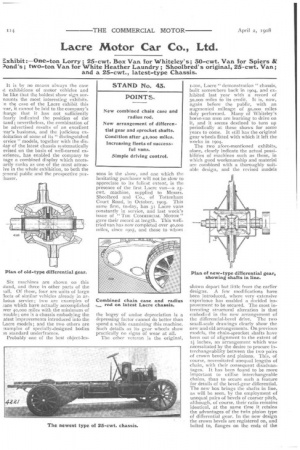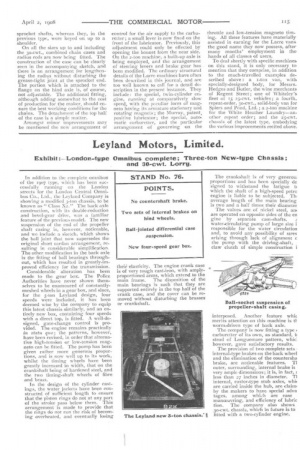Lacre Motor Car Co., Ltd.
Page 24

Page 25

If you've noticed an error in this article please click here to report it so we can fix it.
e,xhibit :—One-ton Lorry ; 25-cwt. Box Van for Whiteley' s; 50.-cwt. Van for Spiers & 3ond's ; two-ton Van for White Heather Laundry ; Shoolbred's original, 25-cwt. Van ; and a 25-cwt., latest-type Chassis.
It is by no means always the case it exhibitions of motor vehicles and he like that the boldest show sign surnounts the most interesting exhibits. n the case of the Lacre exhibit this ,ear, it cannot be laid to the company's !harge that it has not sufficiently Llearly indicated the position of the tand; nevertheless, the combination of he advertised results of an excellent 'ear's business, and the judicious exaoitation of some of its " distinguished ervice " models, together with the dieday of the latest chassis systematically evised on the basis of well-earned exwrience, has enabled the company to tage a combined display which necesarily ranks as one of the most attracive in the whole exhibition, to both the ;eneral public and the prospective putbaser, Six machines are shown on this 3tand, and three in other parts of the mil. Of these, four are units of large leas of similar vehicles already in arluous service; two are examples of ians which have actually accomplished )ver 40,000 miles with the minimum of :rouble; one is a chassis embodying the atest improvements introduced into the Lacre models; and the two others are ?xamples of specially-designed bodies )rt standard underframes.
Probably one of the best object-les
sons in the show, and one which the hesitating purchaser will not be slow to appreciate to its fullest extent, is the presence of the first Lacre van—a 25cwt. machine, supplied to Messrs. Shoolbred and Co., of Tottenham Court Road, in October, 1905. This same firm, to-day, has 31 Lacre vans constantly in service, and last week's issue of " TIIE COMMERCIAL MOTOR." gave their record at length. This welttried van has now completed over 40,000 miles, since 1905, and those to whom
the bogey of undue depreciation is a depressing factor cannot do better than spend a while examining this machine. Such details as its gear wheels show practically no signs of wear at all.
The other veteran is the original, I-ton, Lacre " demonstration " chassis, built somewhere back in 1904, and exhibited last year with a record of 30,000 miles to its credit. It is, now, again before the public, with an augmented mileage of 50,000 miles duly performed. Many of Whiteley's horse-van men are learning to drive on it and it seems destined to turn up periodically at these shows for some years to come. It still has the original gear wheels fitted with which it left the works in 1904.
The two afore-mentioned exhibits, alone, clearly indicate the actual possibilities of machines such as these, in which good workmanship and material are combined with a thoroughly Suitable design, and the revised models shown depart but little from the earlier designs. A few modifications have been introduced, where very extensive experience has enabled a decided improvement to be secured. The most interesting structural alteration is that embodied in the new arrangement of the differential-bevel drive. The two small-scale drawings clearly show the new and old arrangements. On previous models, the chain-sprocket shafts have been out of alignment to the extent of q. inches, an arrangement which was necessitated by the desire to procure interchangeability between the two pairs of crown bevels and pinions. This, of course, necessitated unequal lengths of chain, with their consequent disadvantages. It has been found to be more important to utilise interchangeable chains, than to secure such a feature for details of the bevel-gear differential. The new box brings the shafts in line, as will be seen, by the employment of unequal pairs of bevels of coarser pitch, although, of course, their ratio remains identical, at the same time it retains the advantages of the twin pinion type of differential gear. In the new design the crown bevels are registered on, and bolted to, flanges on the ends of the sprocket shafts, whereas they, in the previous type, were keyed on up to a shoulder.
On all the sizes up to and including the 3o-cwt., combined chain cases and radius rods are now being fitted. The construction of the case can be clearly seen in the accompanying sketch, and there is an arrangement for lengthening the radius without disturbing the grease-tight joint at the sprocket end. The portion which is attached to the flange on the hind axle is, of course, not adjustable. The additional fitting, although adding somewhat to the cost of production for the maker, should ensure the best working conditions for the chains. The. detachment of the top half of the case is a simple matter.
Amongst minor improvements may be mentioned the new arrangement of control for the air supply to the carburetter; a small lever is now fixed on the front of the lubricator. Previously, this adjustment could only be effected by opening the bonnet from the near side. On the 2-ton machine, a built-up axle is being employed, and the arrangement of steering levers and brake gear has been modified. The ordinary structural details of the Lacre machines have often been described in this journal, and are tco well known to call for a detail description in the present instance. They include : the special, twin-cylinder engine, running at comparatively slow speed, with the p::culiar form of magneto having its armature stationary and rotating magnets ; the Murray, patent, positive lubricator ; the special, automatic carburetter, and the particular arrangement of governing on the throttle and low-tension magneto timing. All these features have materially assisted in earning for the Lacre vans the good name they now possess, after many months' employment in the hands of all classes of users.
To deal shortly with specific machines on this stand, it is only necessary to mention that they comprise, in addition to the much-travelled examples described above : a r-tan van, with specially-designed body, for Messrs. Hedges and Butler, the wine merchants of Regent Street; one of Whiteley's fleet of is 25-cwt. vehicles ; a fourth, repeat-order, 3o-cwt., solid-body van for Spiers and Pond, Ltd. ; a 2-ton machine for the White Heather Laundry—another repeat order ; and the 25-cwt. chassis of the latest type, embodying the various improvements recited above.




























































